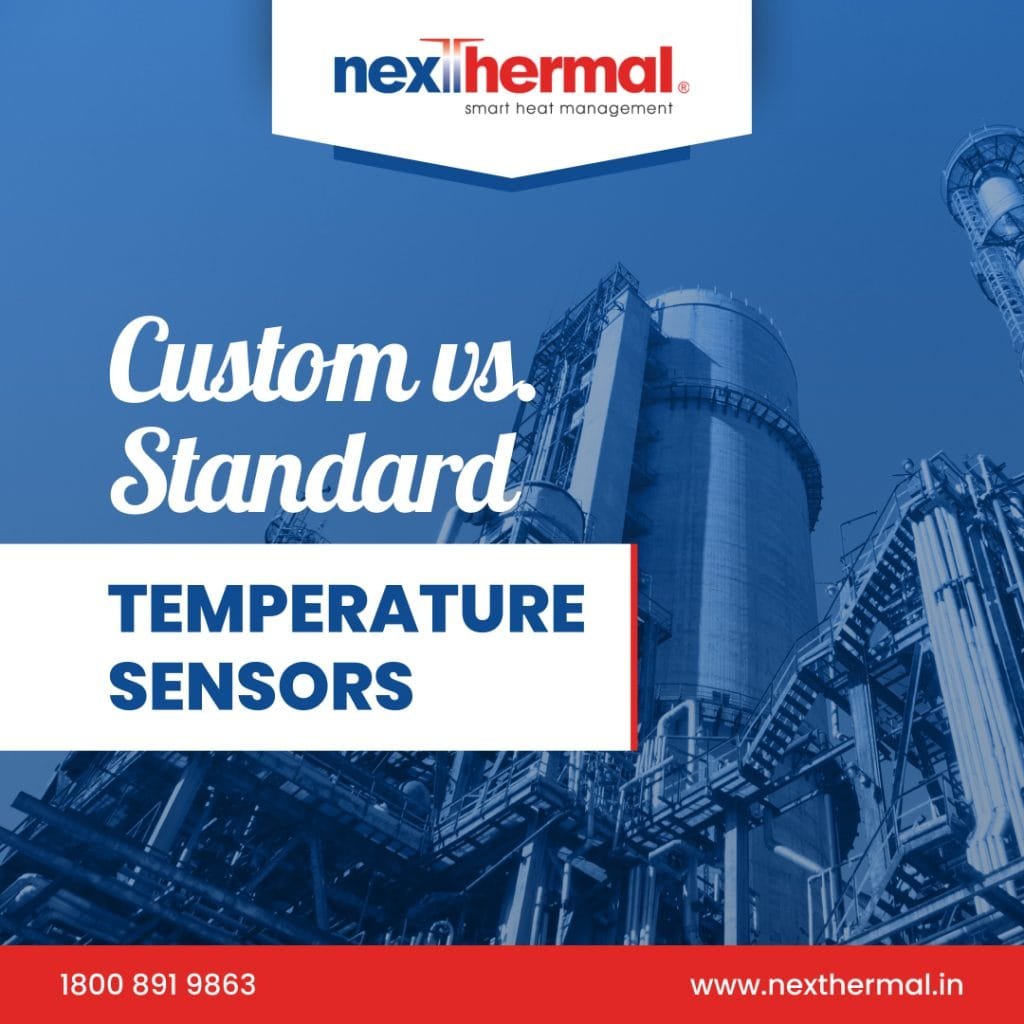Which Type Suits Your Application Best?
In today’s industrial landscape, temperature sensors are vital for ensuring precision, safety, and efficiency across diverse applications. From maintaining product quality in manufacturing to monitoring environmental conditions in pharmaceutical storage, the right temperature sensor can significantly impact your processes. However, choosing between custom temperature sensors and standard temperature sensors can be challenging.
At Nexthermal, we understand the importance of selecting the ideal sensor tailored to your application. This blog will compare the benefits and limitations of custom and standard temperature sensors, focusing on flexibility, cost, and application-specific performance to help you make an informed decision.
Understanding Standard Temperature Sensors
Standard temperature sensors are pre-designed and widely available options that meet general industry requirements. These sensors include commonly used thermocouples, RTDs (Resistance Temperature Detectors), and thermistors that are manufactured to fixed specifications.
Benefits of Standard Temperature Sensors
- Cost-Effectiveness
- Standard sensors are mass-produced, which makes them more affordable compared to custom options. They are ideal for applications with moderate performance needs and limited budgets.
- Availability
- These sensors are readily available and can be sourced quickly, minimizing downtime in cases where replacements are needed.
- Versatility
- Standard sensors often have broad applications and can fit into a variety of systems without requiring significant modifications.
- Established Standards
- Many standard sensors conform to industry-recognized specifications (e.g., ANSI, ISO), ensuring compatibility and reliability.
Limitations of Standard Temperature Sensors
- Limited Customization
- Standard sensors may not meet specific application requirements, such as unique temperature ranges, environments, or mounting configurations.
- Potential for Over-Engineering
- In some cases, standard sensors may include features or capabilities that are unnecessary, leading to inefficiencies or increased costs.
- Performance Gaps in Extreme Conditions
- Standard sensors may fail or deliver inaccurate readings in extreme environments, such as high-vibration machinery or corrosive atmospheres.
Understanding Custom Temperature Sensors
Custom temperature sensors are tailored solutions designed to meet specific application needs. They are engineered to accommodate unique operating conditions, size constraints, and performance requirements.
Benefits of Custom Temperature Sensors
- Application-Specific Design
- Custom sensors are designed to match your exact needs, whether it’s a specific temperature range, faster response time, or compatibility with specialized machinery.
- Enhanced Performance
- With precise calibration and tailored features, custom sensors deliver superior accuracy, reliability, and longevity, even in challenging environments.
- Flexibility in Design
- Nexthermal offers a wide range of customizations, including unique probe lengths, material options, and lead configurations, ensuring seamless integration into your system.
- Cost Efficiency in the Long Run
- While the initial investment may be higher, custom sensors often reduce maintenance, downtime, and energy costs, delivering long-term savings.
- Support for Complex Applications
- For industries like aerospace, medical devices, or advanced manufacturing, where precision is non-negotiable, custom sensors provide the ideal solution.
Limitations of Custom Temperature Sensors
- Higher Initial Cost
- Custom sensors typically require a larger upfront investment due to the design and manufacturing process.
- Longer Lead Time
- Designing and producing custom sensors takes more time compared to purchasing off-the-shelf options.
- Specific Expertise Required
- Custom solutions often require collaboration with experts to determine the best design and materials for your application.
Key Factors to Consider When Choosing Temperature Sensors
1. Application Requirements
- Evaluate your specific needs, such as operating temperature range, environmental conditions, and required accuracy. For highly specialized or extreme environments, custom sensors are often the better choice.
2. Budget Constraints
- If cost is a major consideration and your application has standard performance requirements, a standard sensor may suffice. However, for long-term savings and reduced downtime, a custom sensor can offer better value.
3. Performance and Accuracy
- Custom sensors are designed to meet exact specifications, offering unparalleled performance in critical applications. Standard sensors, while reliable, may not provide the same level of precision in specialized use cases.
4. Environmental Factors
- Consider whether your application involves harsh conditions such as high temperatures, corrosive substances, or mechanical stress. Custom sensors can be designed with durable materials and protective coatings to withstand these challenges.
5. Integration and Compatibility
- If your system has unique design constraints, such as limited space or specific mounting requirements, custom sensors can ensure a seamless fit.
Why Choose Nexthermal for Your Temperature Sensors?
At Nexthermal, we specialize in both standard and custom temperature sensors, offering solutions that are tailored to meet your unique needs.
Our Standard Temperature Sensors
- High-quality thermocouples, RTDs, and thermistors conforming to industry standards.
- Affordable and reliable for a wide range of applications.
Our Custom Temperature Sensors
- Expertly designed for precise temperature measurement and industrial temperature controllers.
- Tailored features such as specific probe lengths, insulation materials, and connector types.
- Engineered to withstand extreme environments and demanding conditions.
Why Nexthermal?
- Experience and Expertise: Decades of experience in providing top-tier temperature sensors for diverse industries.
- Advanced Manufacturing: Cutting-edge facilities and rigorous quality control processes.
- Customer-Centric Approach: Collaboration with clients to ensure sensors meet their exact specifications.
Conclusion
The decision between custom temperature sensors and standard temperature sensors ultimately depends on your application’s specific needs, budget, and operational priorities. While standard sensors offer affordability and convenience, custom sensors deliver unmatched performance and reliability in specialized or demanding environments.
Partnering with Nexthermal ensures you get the best of both worlds—high-quality standard sensors and expertly crafted custom Heating Elements. Explore our range of temperature sensors at Nexthermal and find the perfect fit for your application today.





